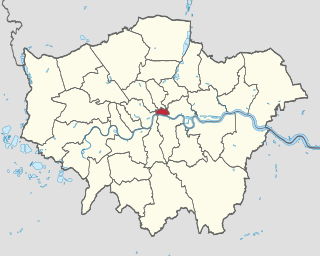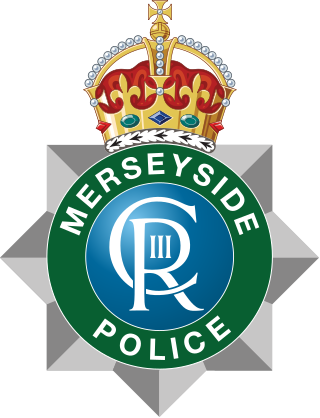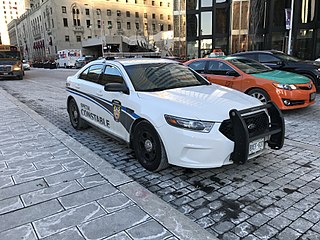Related Research Articles
A constable is a person holding a particular office, most commonly in criminal law enforcement. The office of constable can vary significantly in different jurisdictions. A constable is commonly the rank of an officer within the police. Other people may be granted powers of a constable without holding this title.

Thames Valley Police is the territorial police force responsible for policing the Thames Valley, covering the counties of Berkshire, Buckinghamshire and Oxfordshire. It the largest non-metropolitan police force in England and Wales, covering 2,218 square miles (5,740 km2) and a population of 2.42 million people.

The City of London Police is the territorial police force responsible for law enforcement within the City of London, including the Middle and Inner Temples. The force responsible for law enforcement within the remainder of the London region, outside the city, is the much larger Metropolitan Police, a separate organisation. The City of London, which is now primarily a financial business district with a small resident population but a large commuting workforce, is the historic core of London, and has an administrative history distinct from that of the rest of the metropolis, of which its separate police force is one manifestation.
Police ranks are a system of hierarchical relationships in police organisations. The rank system defines authority and responsibility in a police organisation, and affects the culture within the police force. Usually, uniforms denote the bearer's rank by particular insignia affixed to the uniforms.

The City of Glasgow Police or Glasgow City Police was the police of the City of Glasgow, Scotland. In the 17th century, Scottish cities used to hire watchmen to guard the streets at night, augmenting a force of unpaid citizen constables. On 30 June 1800 the authorities of Glasgow successfully petitioned the British Government to pass the Glasgow Police Act establishing the City of Glasgow Police. It served Glasgow from 1800 to 1975, when it was amalgamated into Strathclyde Police.

Merseyside Police is the territorial police force responsible for policing Merseyside in North West England. The service area is 647 square kilometres with a population of around 1.5 million. As of September 2017 the service has 3,484 police officers, 1,619 police staff, 253 police community support officers, 155 designated officers and 208 special constables. The force is led by Chief Constable Serena Kennedy.

The Hampshire and Isle of Wight Constabulary is the territorial police force responsible for policing the counties of Hampshire and the Isle of Wight in South East England.

The Isle of Man Constabulary is the national police service of the Isle of Man, an island of 85,000 inhabitants, situated approximately equidistant from Northern Ireland, Wales, Scotland and England.
Newham Community Constabulary, formerly called Newham Parks Constabulary, was a very small non-Home Office constabulary responsible for patrolling the 52 parks and open spaces covering 1.63 square miles in the London Borough of Newham.
Police uniforms and equipment in the United Kingdom vary enormously per force or service, and different uniforms and equipment is used for different situations. Both what is worn and what is carried have varied considerably from the inception of the earliest recognisable mainstream police services in the early 19th century. As various laws in the mid-19th century standardised policing in the United Kingdom, so too were uniforms and equipment. From a variety of home grown uniforms, bicycles, swords and pistols the British police force evolved in look and equipment through the long coats and top hat, to the recognisable modern uniform of a white shirt, black tie, reflective jackets, body armour, and the battenburg-marked vehicles, to the present-day Airwave Solutions radios, electric vehicles and tasers.

The River Tyne Police was a police force established under the Newcastle upon Tyne Port Act 1845 which patrolled the River Tyne in England between 1845 and 1968.
The Island Special Constabulary Force (ISCF) was the first reserve to the Jamaica Constabulary Force (JCF) until both forces got the green light to merge on 1 May 2014. Approximately fifty eight percent (58%) of the personnel were deployed in Kingston and St. Andrew. Establishment of the ISCF was 2,091 members, but the most current strength was 1,446. James Golding served as the last head of the Island Special Constabulary Force (ISCF).

A special constable or special police constable can refer to an auxiliary or part-time law enforcement officer or a person who is granted certain (special) police powers.
Liverpool Markets Police was a police force maintained by Liverpool City Council to police the markets owned by the city.
Brighton Parks Police was a park police force maintained by Brighton Borough Council for the borough of Brighton, England.
Florence Mildred White was an English policewoman. She was likely to have been the first documented woman to join a police force in England and Wales, and to be attested immediately as a Constable. Later she was to become the first attested woman officer holding the rank of Inspector, and the first woman police officer to receive a pension on retirement.
The Londonderry Borough Police was the police force in the city of Derry, County Londonderry, Ireland, from 1848 to 1870, nicknamed the Horney Dicks after the bones used in their helmets. They replaced the earlier town watch and were in turn replaced by the Royal Irish Constabulary (RIC). The police force was established by the Londonderry Improvement Act 1848 and were governed by the Londonderry Corporation. Its abolition was recommended by a royal commission of inquiry into sectarian riots in the city in 1869. The commission felt the force, having the form of a town watch, was inadequate to policing serious crime; it also noted, but did not endorse, allegations that the police discriminated against Roman Catholics.
Penzance Borough Police was the police force for the borough and corporate town of Penzance, Cornwall, from 1836 to 1947. It was formed following the passing of the Municipal Corporations Act 1835, which reformed all UK boroughs, and stipulated that each appoint a Watch Committee to oversee a police force. The police force formed part of the commonality of the town's government, led by an elected Mayor, six aldermen and eighteen councillors.

Truro City Police, known as Truro Borough Police until 1877, was the police force for the corporate town of Truro, Cornwall, from 1836 to 1921. It was established under the terms of the Municipal Corporations Act 1835 which required every town to appoint a council and a Police Watch Committee, which was responsible for overseeing a police force.

The Hampstead Heath Constabulary (HHC) is the organisation that patrols Hampstead Heath, London, which is administered by the City of London Corporation.
References
- Main reference: Liverpool Parks Police: A Historical Perspective